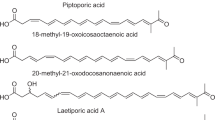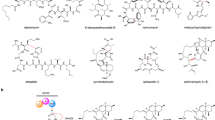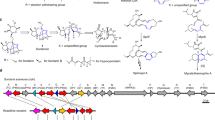Abstract
Fungal bicyclo[2.2.2]diazaoctane indole alkaloids represent an important family of natural products with a wide spectrum of biological activities. Although biomimetic total syntheses of representative compounds have been reported, the details of their biogenesis, especially the mechanisms for the assembly of diastereomerically distinct and enantiomerically antipodal metabolites, have remained largely uncharacterized. Brevianamide A represents a basic form of the subfamily bearing a dioxopiperazine core and a rare 3-spiro-ψ-indoxyl skeleton. In this study, we have identified the brevianamide A biosynthetic gene cluster from Penicillium brevicompactum NRRL 864 and elucidated the metabolic pathway. BvnE was revealed to be an essential isomerase/semipinacolase that specifies the selective production of the natural product. Structural elucidation, molecular modelling and mutational analysis of BvnE as well as quantum chemical calculations have provided mechanistic insights into the diastereoselective formation of the 3-spiro-ψ-indoxyl moiety in brevianamide A. This occurs through a BvnE-controlled semipinacol rearrangement and a subsequent spontaneous intramolecular [4+2] hetero-Diels–Alder cycloaddition.

This is a preview of subscription content, access via your institution
Access options
Access Nature and 54 other Nature Portfolio journals
Get Nature+, our best-value online-access subscription
$29.99 / 30 days
cancel any time
Subscribe to this journal
Receive 12 digital issues and online access to articles
$119.00 per year
only $9.92 per issue
Buy this article
- Purchase on Springer Link
- Instant access to full article PDF
Prices may be subject to local taxes which are calculated during checkout






Similar content being viewed by others
Data availability
The sequence data referenced in this study are available in GenBank with the accession number MN401751. Coordinates and associated structure factors have been deposited in the Protein Data Bank (PDB) with PDB ID 6U9I (BvnE) and in the Cambridge Crystallographic Data Centre (CCDC) with the CCDC numbers 1973959 (BX), 1973957 (BY) and 1973958 (15). Molecular coordinates as well as absolute and relative thermochemistry data have been provided for the computational studies. All other data are available from the corresponding authors on reasonable request.
References
Klas, K. R. et al. Structural and stereochemical diversity in prenylated indole alkaloids containing the bicyclo[2.2.2]diazaoctane ring system from marine and terrestrial fungi. Nat. Prod. Rep. 35, 532–558 (2018).
Birch, A. J. & Wright, J. J. The brevianamides: a new class of fungal alkaloid. J. Chem. Soc. D 644b–645b (1969).
Li, S. et al. Comparative analysis of the biosynthetic systems for fungal bicyclo[2.2.2]diazaoctane indole alkaloids: the (+)/(–)-notoamide, paraherquamide and malbrancheamide pathways. MedChemComm 3, 987–996 (2012).
Finefield, J. M., Frisvad, J. C., Sherman, D. H. & Williams, R. M. Fungal origins of the bicyclo[2.2.2]diazaoctane ring system of prenylated indole alkaloids. J. Nat. Prod. 75, 812–833 (2012).
Sanzcervera, J. F., Glinka, T. & Williams, R. M. Biosynthesis of the brevianamides: quest for a biosynthetic Diels–Alder cyclization. J. Am. Chem. Soc. 115, 347–348 (1993).
Sanzcervera, J. F., Glinka, T. & Williams, R. M. Biosynthesis of brevianamides A and B: in search of the biosynthetic Diels–Alder construction. Tetrahedron 49, 8471–8482 (1993).
Williams, R. M., Sanz-Cervera, J. F., Sancenon, F., Marco, J. A. & Halligan, K. Biomimetic Diels–Alder cyclizations for the construction of the brevianamide, paraherquamide sclerotamide, and VM55599 ring systems. J. Am. Chem. Soc. 120, 1090–1091 (1998).
Adams, L. A., Valente, M. W. N. & Williams, R. M. A concise synthesis of d,l-brevianamide B via a biomimetically-inspired IMDA construction. Tetrahedron 62, 5195–5200 (2006).
Williams, R. M. & Cox, R. J. Paraherquamides, brevianamides, and asperparalines: laboratory synthesis and biosynthesis. An interim report. Acc. Chem. Res. 36, 127–139 (2003).
Stocking, E. M. & Williams, R. M. Chemistry and biology of biosynthetic Diels–Alder reactions. Angew. Chem. Int. Ed. 42, 3078–3115 (2003).
Dan, Q. et al. Fungal indole alkaloid biogenesis through evolution of a bifunctional reductase/Diels–Alderase. Nat. Chem. 11, 972–980 (2019).
Williams, R. M., Glinka, T. & Kwast, E. Facial selectivity of the intramolecular SN2′ cyclization: stereocontrolled total synthesis of brevianamide B. J. Am. Chem. Soc. 110, 5927–5929 (1988).
Williams, R. M., Kwast, E., Coffman, H. & Glinka, T. Remarkable, enantio-divergent biogenesis of brevianamide A and B. J. Am. Chem. Soc. 111, 3064–3065 (1989).
Porter, A. E. A. & Sammes, P. G. A Diels–Alder reaction of possible biosynthetic importance. J. Chem. Soc. D 1103a (1970).
Li, F. et al. Determination of taichunamide H and structural revision of taichunamide A. Org. Lett. 20, 1138–1141 (2018).
Greshock, T. J. et al. Isolation, structure elucidation, and biomimetic total synthesis of versicolamide B, and the isolation of antipodal (–)-stephacidin A and (+)-notoamide B from Aspergillus versicolor NRRL 35600. Angew. Chem. Int. Ed. 47, 3573–3577 (2008).
Kai, A., Kato, H., Sherman, D. H., Williams, R. M. & Tsukamoto, S. Isolation of a new indoxyl alkaloid, Amoenamide B, from Aspergillus amoenus NRRL 35600: biosynthetic implications and correction of the structure of Speramide B. Tetrahedron Lett. 59, 4236–4240 (2018).
Xu, X., Zhang, X., Nong, X., Wang, J. & Qi, S. Brevianamides and mycophenolic acid derivatives from the deep-sea-derived fungus Penicillium brevicompactum DFFSCS025. Mar. Drugs 15, 43 (2017).
Godfrey, R. C., Green, N. J., Nichol, G. S. & Lawrence, A. L. Total synthesis of brevianamide A. Nat. Chem. https://doi.org/10.1038/s41557-020-0442-3 (2020).
Mori, T. et al. Molecular basis for the unusual ring reconstruction in fungal meroterpenoid biogenesis. Nat. Chem. Biol. 13, 1066–1073 (2017).
Li, S. et al. Biochemical characterization of NotB as an FAD-dependent oxidase in the biosynthesis of notoamide indole alkaloids. J. Am. Chem. Soc. 134, 788–791 (2012).
Ding, Y. et al. Genome-based characterization of two prenylation steps in the assembly of the stephacidin and notoamide anticancer agents in a marine-derived Aspergillus sp. J. Am. Chem. Soc. 132, 12733–12740 (2010).
Kato, N. et al. Identification of cytochrome P450s required for fumitremorgin biosynthesis in Aspergillus fumigatus. ChemBioChem 10, 920–928 (2009).
Li, H. et al. HPLC–DAD-directed isolation of linearly fused prenylated indole alkaloids from a soil-derived Aspergillus versicolor. J. Nat. Prod. 82, 2181–2188 (2019).
Matsuda, Y. et al. Discovery of key dioxygenases that diverged the paraherquonin and acetoxydehydroaustin pathways in Penicillium brasilianum. J. Am. Chem. Soc. 138, 12671–12677 (2016).
Sutor, D. J. The C–H···O hydrogen bond in crystals. Nature 195, 68–69 (1962).
Schwalbe, C. H. June Sutor and the C–H···O hydrogen bonding controversy. Crystallogr. Rev. 18, 191–206 (2012).
Goswami, R. S. Targeted gene replacement in fungi using a split-marker approach. Methods Mol. Biol. 835, 255–269 (2012).
Heneghan, M. N. et al. First heterologous reconstruction of a complete functional fungal biosynthetic multigene cluster. ChemBioChem 11, 1508–1512 (2010).
Kabsch, W. XDS. Acta Crystallogr. D 66, 125–132 (2010).
McCoy, A. J. et al. Phaser crystallographic software. J. Appl. Crystallogr. 40, 658–674 (2007).
Emsley, P., Lohkamp, B., Scott, W. G. & Cowtan, K. Features and development of Coot. Acta Crystallogr. D 66, 486–501 (2010).
Adams, P. D. et al. PHENIX: a comprehensive Python-based system for macromolecular structure solution. Acta Crystallogr. D 66, 213–221 (2010).
Chen, V. B. et al. MolProbity: all-atom structure validation for macromolecular crystallography. Acta Crystallogr. D 66, 12–21 (2010).
Morris, G. M. et al. AutoDock4 and AutoDockTools4: automated docking with selective receptor flexibility. J. Comput. Chem. 30, 2785–2791 (2009).
Williams, R. M., Sanz-Cervera, J. F., Sancenon, F., Marco, J. A. & Halligan, K. M. Biomimetic Diels–Alder cyclizations for the construction of the brevianamide, paraherquamide, sclerotamide, asperparaline and VM55599 ring systems. Biorg. Med. Chem. 6, 1233–1241 (1998).
Acknowledgements
This work was supported by the National Key Research and Development Program (2019YFA0905100 and 2019YFA0706900), the National Natural Science Foundation of China (21472204 and 31872729 to S.L. and 31800041 to L.D.), the National Institutes of Health R35 GM118101, the Hans W. Vahlteich Professorship (to D.H.S.), R01 CA070375 (to R.M.W. and D.H.S.), the Shandong Provincial Natural Science Foundation (ZR2019ZD20 to S.L. and ZR201807060986 to L.D.), the National Postdoctoral Innovative Talents Support Program (BX20180325 to L.D.), the China Postdoctoral Science Foundation (2019M652500 to L.D.) and funding from the NSF (grant no. CHE-0840456, for X-ray instrumentation). GM/CA@APS is supported by the National Institutes of Health, the National Institute of General Medical Sciences (AGM-12006) and the National Cancer Institute (ACB-12002). We thank J. L. Smith from the University of Michigan for her assistance with the structure determination of BvnE. R.S.P. acknowledges computational resources from the RMACC Summit supercomputer supported by the National Science Foundation (ACI-1532235 and ACI-1532236), the University of Colorado Boulder and Colorado State University, and the Extreme Science and Engineering Discovery Environment (XSEDE) through allocation TG-CHE180056. XSEDE is supported by the National Science Foundation (ACI-1548562). The authors thank X. Li and H. Sui from The State Key Laboratory of Microbial Technology, Shandong University for their assistance with single-crystal X-ray diffraction.
Author information
Authors and Affiliations
Contributions
Y.Y., L.D., R.M.W., D.H.S. and S.L. contributed to the experimental design. Y.Y., L.D., W.Z. and F.Q. performed molecular cloning, fungal genetics and compound purification. Y.Y., L.D. and X.Z. performed structural assignment (NMR analysis). Y.Y., L.D., S.A.N., A.E.F. and M.L.A.-C. performed molecular cloning, protein expression and purification. Y.Y. and L.D. performed enzymatic assays, and LC–MS and HPLC analyses. S.A.N. and M.L.A.-C. carried out all crystallographic experiments and structural analyses. Y.Y. performed structure-based site-directed mutagenesis. W.Z. performed genome mining of the gene cluster. M.M., N.A.C., V.V.S. and S.M. synthesized and validated the compounds described in this study. J.V.A.-R and R.S.P. performed DFT calculations. A.M. and H.O. supplied the heterologous expression system. H.K. and S.T. performed ECD measurements and calculations. Y.Y., L.D., S.A.N., R.S.P., R.M.W., D.H.S. and S.L. analysed the data and prepared the manuscript.
Corresponding authors
Ethics declarations
Competing interests
The authors declare no competing interests.
Additional information
Publisher’s note Springer Nature remains neutral with regard to jurisdictional claims in published maps and institutional affiliations.
Extended data
Extended Data Fig. 1 Representative fungal bicyclo[2.2.2]diazaoctane indole alkaloids.
Compounds with 3-spiro-ψ−indoxyls, spiro-2-oxindoles and 3-hydroxyindolenines are presented in red, blue and green, respectively.
Extended Data Fig. 2 The biosynthetic gene clusters for representative fungal bicyclo[2.2.2]indole alkaloids.
The gene clusters not, mal and phq are responsible for biosynthesis of notoamides, malbrancheamides and parapherquamides, respectively.
Extended Data Fig. 3 Biogenetic proposals for Brevianamide A (BA) and Brevianamide B (BB).
a, Early biosynthetic proposal suggested and interrogated by Williams et. al13. b, Original biogenesis proposed by Porter and Sammes (via 7)14. c, More recent biosynthetic proposals suggested by Williams et al.5,6,10. Several biogenetic hypotheses based on the pioneering proposal first suggested by Porter and Sammes in 197014 reasoned that the bicyclo[2.2.2]diazaoctane core arises via an intramolecular [4+2] hetero-Diels-Alder (IMDA) construction5,6,7,8,9,10,36. We experimentally interrogated the biogenetic proposal a, through the synthesis of 13C-labeled putative Diels-Alder products (±)-20, but could not detect incorporation into either BA or BB in cultures of Pb. Based on these results, we then suggested the biosynthetic pathways illustrated in b and c. The fundamental difference between the biogenesis described in a, and that in b and c, is the sequential timing of the indole oxidation, the semipinacol rearrangement and the crucial IMDA reactions. Thus, it remained conceivable that oxidation of DE to the (R)-hydroxyindolenine provides species 11, which can suffer several fates. One is N-C ring closure to co-metabolite Brevianamide E (BE); a second possibility shown in b is oxidation and tautomerization to the azadiene species 13, which can suffer IMDA cyclization providing 7 and 8, then undergo a final semipinacol rearrangement to furnish BA and BB (route i). Alternatively, azadiene 13 could first suffer semipinacol rearrangement to 10, which then undergoes the IMDA construction to generate BA and BB (route ii). Another possibility c involves (R)-hydroxyindolenine 11, which proceeds through a semipinacol rearrangement to the indoxyl species 19, followed by further oxidation to the azadiene species 10 and subsequent IMDA to furnish BA and BB. Experimental supports to distinguish between these proposed pathways, all of which embrace the relative and absolute stereochemistry of BA and BB, have remained unresolved until this work.
Extended Data Fig. 4 Elucidation of absolute configurations.
a, Experimental and computational CD spectra of 7. b, Experimental and computational CD spectra of 16. c, Experimental and computational CD spectra of 17. d, X-ray ORTEP diagram of BX. e, X-ray ORTEP diagram of BY. f, X-ray ORTEP diagram of 15.
Extended Data Fig. 5 Enzyme properties of BvnE using compound 15 as a substrate.
a, pH dependency. b, temperature dependency. c, Michaelis-Menton kinetic analysis (centre values, means; error bars, standard deviations; n = 2).
Extended Data Fig. 6 Docking results and CD spectra of BvnE.
a, Docking complex of BvnE with compound 13 (magenta). b, CD spectra of purified wild-type and mutant BvnE proteins. c, Electron density (2Fo-Fc, 1σ) for the active site residues of BvnE (PDB ID code: 6U9I) shows conformational flexibility at Arg38 and Glu131 suggestive of potential active site remodeling during catalysis. Arg38 (red box) which is essential for catalytic activity does not make direct interactions with the docked ligand or active site residues. However, the structure reveals two ordered water molecules (red spheres) in a hydrogen bonding network between Arg38 and Glu131. These binding poses reveal possible key interactions between the ligand and BvnE.
Supplementary information
Supplemental Information
Supplementary Methods, Tables 1–9, Figs. 1–91 and refs. 1–40.
Computational Data 1
Molecular coordinates in the chemical calculations.
Computational Data 2
Absolute and relative thermochemistry data E_waterDLPNO = energy obtained in the single-point energy corrections, E = energy obtained in the geometry optimizations, ZPE = zero-point energy, H_waterDLPNO = enthalpy corrected with E_waterDLPNO, T.S = temperature times entropy with no corrections, T.qh-S = temperature times entropy with quasi-harmonic S corrections, G(T)_waterDLPNO = Gibbs free energy corrected only with E_waterDLPNO, qh-G(T)_waterDLPNO = Gibbs free energy with E_waterDLPNO and quasi-harmonic S corrections.
Crystallographic Data 1
Crystallographic Information File for brevianamide X (BX).
Crystallographic Data 2
Crystallographic Information File for brevianamide Y (BY).
Crystallographic Data 3
Crystallographic Information File for compound 15.
Rights and permissions
About this article
Cite this article
Ye, Y., Du, L., Zhang, X. et al. Fungal-derived brevianamide assembly by a stereoselective semipinacolase. Nat Catal 3, 497–506 (2020). https://doi.org/10.1038/s41929-020-0454-9
Received:
Accepted:
Published:
Issue Date:
DOI: https://doi.org/10.1038/s41929-020-0454-9
This article is cited by
-
Mn(I)-catalyzed sigmatropic rearrangement of β, γ-unsaturated alcohols
Nature Communications (2023)
-
Genome mining for unknown–unknown natural products
Nature Chemical Biology (2023)
-
Efficient production of a cyclic dipeptide (cyclo-TA) using heterologous expression system of filamentous fungus Aspergillus oryzae
Microbial Cell Factories (2022)
-
Structural basis of the stereoselective formation of the spirooxindole ring in the biosynthesis of citrinadins
Nature Communications (2021)
-
The important role of P450 monooxygenase for the biosynthesis of new benzophenones from Cytospora rhizophorae
Applied Microbiology and Biotechnology (2021)



